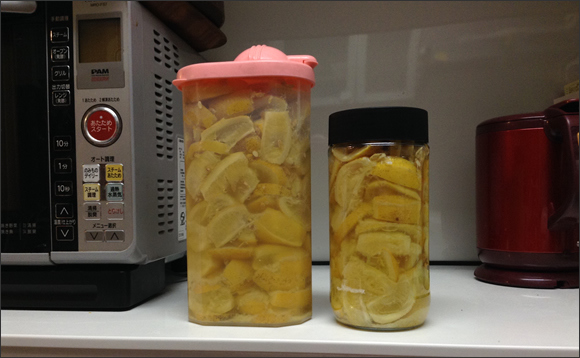
Did you know that salty things have gotten really popular in Japan in recent years? The Japanese word for salt is shio, and these days you can find shio yakisoba (buckwheat noodles), shiokouji (a kind of condiment), shio nabe (hotpot), and the new fad shio tomato. And now it’s even extending into the world of sweets with shio vanilla ice cream and shio chocolate. I’ve had sea salt chocolate before, and I can tell you it’s actually much better than it sounds! The latest addition to the ranks of salty goodness is shio lemon, which you can make at home yourself with just two basic and obvious ingredients.
Apparently salted lemon is used in Morocco as a seasoning. It’s basically cut lemon pickled in salt, and is very easy to make. So what can you do with it? Well, you could chop it up and put it in miso soup like yuzu, make it into a paste and use it as a rub for meat, or use it as an extract on raw squid if you’re feeling extra adventurous that day. And it stays good for two years!
Our lemon-loving writer over at RocketNews24’s sister site Pouch decided that she wanted to give this simple recipe a go. Here’s a direct quote from her, so you can see why she was suitable for this project: “I always put lemon on my karaage (fried chicken)! I add lemon before frying them! And then add more lemon!”
Unfortunately, loving all things lemony wasn’t enough to stop this turning into a bit of a disaster…
Right, time to actually do this! (Scroll down to the bottom for the full, super simple recipe).
You use the peel itself for this, so you should try and get organic, in other words pesticide-free, lemons. Our writer looked it up on the Net and found some home grown in Hiroshima at 1,980 yen (around $20 USD) for 3 kilograms. And this is where things started to go wrong, because she didn’t realize just how much 3kg was…
Her order arrived after three days…
…And it contained a lot of lemons. 30 to be precise.
She admitted that she was disappointed to find that the color and shape was inconsistent and some parts of the skins were dry. (Bear in mind that organic food is not popular in Japan, and people are used to their fruit and veg looking unbelievably perfect.)
But the problem wasn’t the look, it was the amount! What to do with them all? She didn’t have a bottle big enough to hold them all! But she did spend money on them… and shio lemon is supposed to keep for 2 years…
In the end she decided to just go for it, and use them all! We know what kind of gifts all her friends will be getting for the next two years…
Desperate time call for desperate measures. With no jar big enough to put them in, she ended up using a plastic bag. With a glass jar you can boil it in water to sterilize it but a bag would sort of melt, so she used some alcohol disinfectant spray that’s safe to use on your dishes.
Next she washed the lemons and cut them into vertical pieces, chopping off any bad bits as she went along. “Chop chop chop… argh! I’m fed up of this! I’m fed up after three lemons!” By the tenth her fingers were tingling from the acid, and by the end she proclaimed that her kitchen smelled like toilet cleaner.
Is there some special reason for cutting some horizontally and some vertically? “I got fed up of chopping vertically, so half way through I changed to cutting round slices.” It took around 20 minutes to cut them all up. There were a lot of leftover bits in the tub to the side, which she thought was quite wasteful, so she’s hanging on to them to make candied peel later.
The important question is how much salt to use? The answer to that is 10% of the weight of your lemons. But since she’d got rid of a lot of bad bits she didn’t know the weight anymore! So it was time to get out the kitchen scales – but it turned out that the bag was too heavy! Time for the bathroom scales. The total weight of the cut lemons came to 2.7 kilograms, and 10% of that is 270 grams, which is quite a lotta salt.
“I felt like a sumo wrestler scattering salt in the sumo ring. Dosukoi!” (Dosukoi! is a shout that sumo wrestlers give.)
Next she smooshed it all around so that the lemons were completely covered in salt, and the juice started to collect at the bottom.
Usually when you’re making shio lemon, you leave it to stand for one month, shaking the container every few days to spread the salt and help it dissolve in the lemon juice. But with 3 kilograms of her concoction sitting in a plastic bag, it proved very difficult to move around. She did her best to mix it around every day as the mixture became gloopier. However…
“On the 4th day as I was enthusiastically doing my daily shake, my hands came away sticky. I gave it a lick, and it was sour! And a bit salty!” Due to the weight of the lemons and the constant movement, the bag had split!! Our writer then did the sensible thing and finally transferred the now squishy lemons into other containers. Remember that due to the acid you can’t use anything with metal, so no jam jars with metal lids. So here’s the lesson kids: Don’t try and make this in a plastic bag!
In the end she used an instant coffee can and a pitcher for iced tea. Make sure the lids are screwed on tightly!
After two weeks she decided to give her creation a taste test, and was surprised by how mild it was. There was no tooth-tingling tartness like when you bite into a raw lemon, and it also wasn’t overly salty. But the smell was still fresh and bracing. There was some sour flavour left in the peel, but this should also gradually dissipate. In conclusion, she said that“It was a pain to make, but now I’m really looking forward to it being finished!”
Recipe
Ingredients:
Lemons (as much as you like)
Salt (10% of the weight of your lemons)
Containers that don’t use metal
How to make it:
1. Wash and dry the lemons, then cut off and throw away the ends. Cut the lemons into wedges.
2. Fill the sterilized container with the salt and the lemons in layers.
3. Leave to ferment at room temperature, shaking it from time to time to dissolve the salt. If the lemons don’t release much juice, you can top it up with more.
4. Leave for around one month, and once all the salt is dissolved it’s ready! From now on keep it in the refridgerator.
It really is that simple, as long as you don’t go overboard when you’re buying the lemons!
Source and Images: RocketNews24
[ Read in Japanese ]

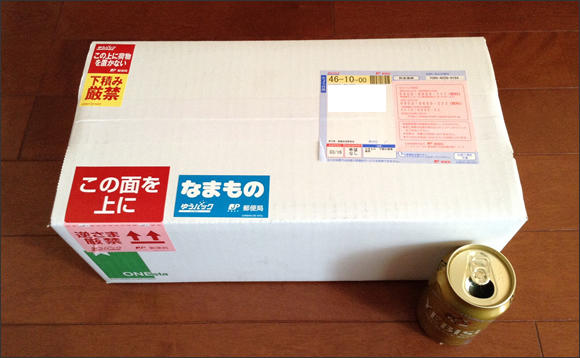
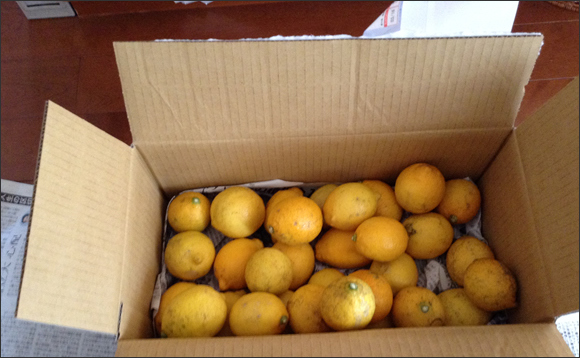
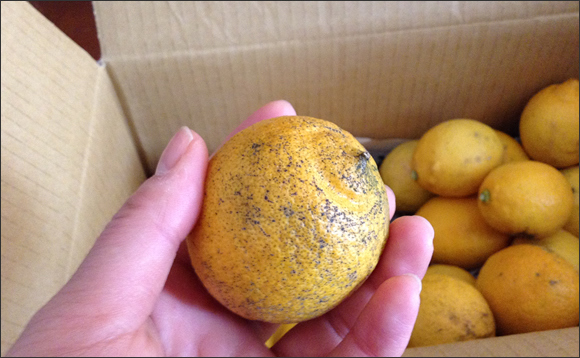
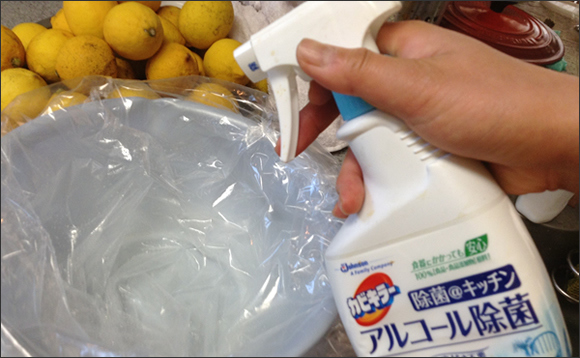
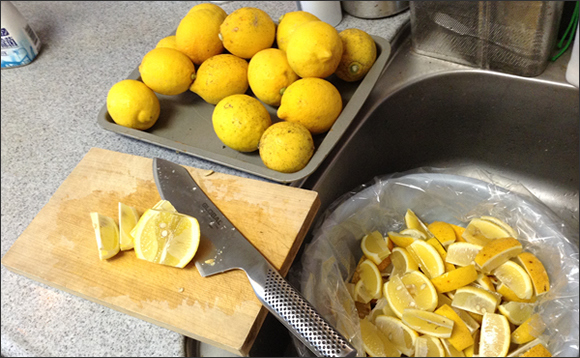
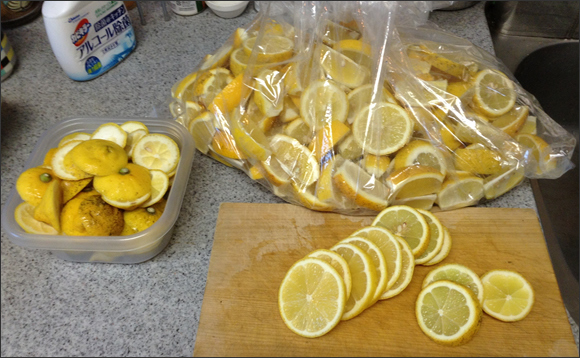

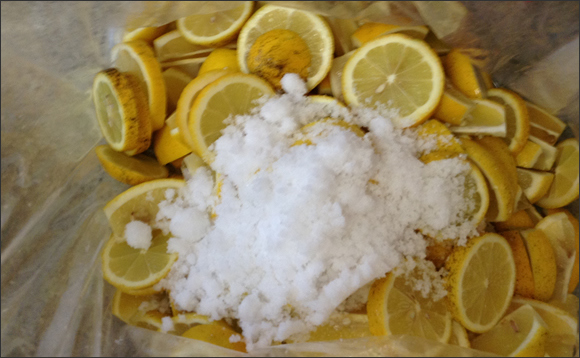
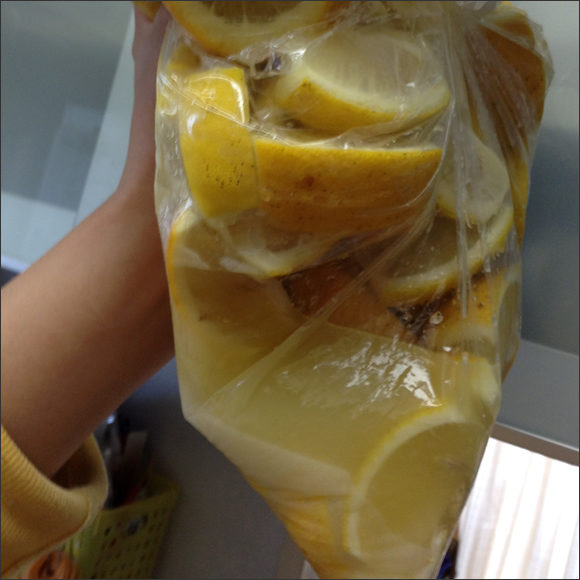
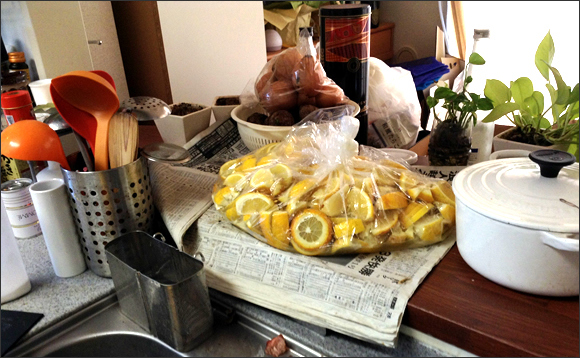

 We try out Japanese candy maker’s recipes for how to make hard candy drinkable【SoraKitchen】
We try out Japanese candy maker’s recipes for how to make hard candy drinkable【SoraKitchen】 Starbucks now has a Lemon Zest Macchiato, limited for sale at only nine locations in Japan
Starbucks now has a Lemon Zest Macchiato, limited for sale at only nine locations in Japan Japanese tabloid puts out Lemon Sour with 13 percent alcohol【Taste test】
Japanese tabloid puts out Lemon Sour with 13 percent alcohol【Taste test】 Taste-testing Japan’s beef tongue/gacha beef vending machine in Sendai【Taste test】
Taste-testing Japan’s beef tongue/gacha beef vending machine in Sendai【Taste test】 Nailing it! Japanese internet shares three super easy ways to take care of your nails
Nailing it! Japanese internet shares three super easy ways to take care of your nails How to order snacks on a Shinkansen bullet train in Japan
How to order snacks on a Shinkansen bullet train in Japan Hello, cosmetics! Clinique teams up with Hello Kitty this summer for first-time collaboration
Hello, cosmetics! Clinique teams up with Hello Kitty this summer for first-time collaboration Demon Slayer: Kimetsu no Yaiba gets new roller coaster attractions and food at Universal Studios Japan
Demon Slayer: Kimetsu no Yaiba gets new roller coaster attractions and food at Universal Studios Japan A visit to the best UFO catcher arcade in the universe!
A visit to the best UFO catcher arcade in the universe! To combat declining birth rate, Japan to begin offering “Breeding Visas” to foreigners
To combat declining birth rate, Japan to begin offering “Breeding Visas” to foreigners Spirited Away train station and submerged tracks attract Ghibli fans around Japan
Spirited Away train station and submerged tracks attract Ghibli fans around Japan Daiso DIY dessert! 100 yen store’s super-easy mochi sweets kit is our new hero
Daiso DIY dessert! 100 yen store’s super-easy mochi sweets kit is our new hero How should you respond when a Japanese person gives you a compliment?
How should you respond when a Japanese person gives you a compliment? New samurai glasses are Japan’s latest weird must-have souvenir
New samurai glasses are Japan’s latest weird must-have souvenir McDonald’s adds new watermelon frappe and fruity macaron to its menu in Japan
McDonald’s adds new watermelon frappe and fruity macaron to its menu in Japan Nintendo history you can feel – Super NES, N64, and GameCube controllers become capsule toys
Nintendo history you can feel – Super NES, N64, and GameCube controllers become capsule toys “The most Delicious Cup Noodle in history” – Japan’s French Cup Noodle wins our heart【Taste test】
“The most Delicious Cup Noodle in history” – Japan’s French Cup Noodle wins our heart【Taste test】 Starbucks releases a cute Frappuccino and Unicorn Cake…but not in Japan
Starbucks releases a cute Frappuccino and Unicorn Cake…but not in Japan Kyoto Tower mascot termination reveals dark side behind cute Japanese characters
Kyoto Tower mascot termination reveals dark side behind cute Japanese characters McDonald’s Japan’s Soft Twist Tower: A phantom ice cream only sold at select branches
McDonald’s Japan’s Soft Twist Tower: A phantom ice cream only sold at select branches Yabai Ramen: What makes this Japanese ramen so dangerous?
Yabai Ramen: What makes this Japanese ramen so dangerous? Finally! Nintendo Japan expands Switch 8-bit controller sales to everybody, Online member or not
Finally! Nintendo Japan expands Switch 8-bit controller sales to everybody, Online member or not Japanese government wants to build luxury resorts in all national parks for foreign tourists
Japanese government wants to build luxury resorts in all national parks for foreign tourists 10 things you should buy at 7-Eleven in Japan
10 things you should buy at 7-Eleven in Japan Studio Ghibli releases anime heroine cosplay dresses that are super comfy to wear
Studio Ghibli releases anime heroine cosplay dresses that are super comfy to wear Woman charged for driving suitcase without a license in Osaka
Woman charged for driving suitcase without a license in Osaka Studio Ghibli unveils My Neighbour Totoro miniature house model
Studio Ghibli unveils My Neighbour Totoro miniature house model Kyoto experiencing problems with foreign tourists not paying for bus fares, but not on purpose
Kyoto experiencing problems with foreign tourists not paying for bus fares, but not on purpose Fighting mild hunger with a Japanese soda that turns into jelly in the stomach【Taste test】
Fighting mild hunger with a Japanese soda that turns into jelly in the stomach【Taste test】 Studio Ghibli’s Howl’s Moving Castle tapestry unveiled in Japan for first time
Studio Ghibli’s Howl’s Moving Castle tapestry unveiled in Japan for first time McDonald’s new Happy Meals offer up cute and practical Sanrio lifestyle goods
McDonald’s new Happy Meals offer up cute and practical Sanrio lifestyle goods Sales of Japan’s most convenient train ticket/shopping payment cards suspended indefinitely
Sales of Japan’s most convenient train ticket/shopping payment cards suspended indefinitely Sold-out Studio Ghibli desktop humidifiers are back so Totoro can help you through the dry season
Sold-out Studio Ghibli desktop humidifiers are back so Totoro can help you through the dry season Japanese government to make first change to romanization spelling rules since the 1950s
Japanese government to make first change to romanization spelling rules since the 1950s Foreigner’s request for help in Tokyo makes us sad for the state of society
Foreigner’s request for help in Tokyo makes us sad for the state of society Ghibli founders Toshio Suzuki and Hayao Miyazaki contribute to Japanese whisky Totoro label design
Ghibli founders Toshio Suzuki and Hayao Miyazaki contribute to Japanese whisky Totoro label design Doraemon found buried at sea as scene from 1993 anime becomes real life【Photos】
Doraemon found buried at sea as scene from 1993 anime becomes real life【Photos】 Tokyo’s most famous Starbucks is closed
Tokyo’s most famous Starbucks is closed Princesses, fruits, and blacksmiths: Study reveals the 30 most unusual family names in Japan
Princesses, fruits, and blacksmiths: Study reveals the 30 most unusual family names in Japan How to make cheese with just three ingredients【SoraKitchen】
How to make cheese with just three ingredients【SoraKitchen】 Lemon & Cheese pies from McDonald’s bring some sunshine to the rainy season【Taste test】
Lemon & Cheese pies from McDonald’s bring some sunshine to the rainy season【Taste test】 How to make yoghurt ramen with instant noodles
How to make yoghurt ramen with instant noodles Coca-Cola Company releasing “Demon Lemon” canned Japanese cocktails across the country
Coca-Cola Company releasing “Demon Lemon” canned Japanese cocktails across the country Can fresh lemon neutralize spicy curry and ramen? RocketNews24 investigates! 【RocketScience】
Can fresh lemon neutralize spicy curry and ramen? RocketNews24 investigates! 【RocketScience】 U.S. Rapper Lil Baby makes waves in Japan, but for something other than his music
U.S. Rapper Lil Baby makes waves in Japan, but for something other than his music Seaweed Salt Potato Butter Bacon Teriyaki Egg Burgers from McDonald’s are a mouthful
Seaweed Salt Potato Butter Bacon Teriyaki Egg Burgers from McDonald’s are a mouthful A call to arms: 5 Japanese potato chip flavours the west badly needs
A call to arms: 5 Japanese potato chip flavours the west badly needs Starbucks Japan’s new cake Frappuccino brings sunshine to our taste buds
Starbucks Japan’s new cake Frappuccino brings sunshine to our taste buds Häagen-Dazs Japan tells us to put ice cream on our avocado toast — Were we wrong to listen?
Häagen-Dazs Japan tells us to put ice cream on our avocado toast — Were we wrong to listen? Clever new packaging trick helps make it easier to eat instant ramen without ruining your health
Clever new packaging trick helps make it easier to eat instant ramen without ruining your health Suntory’s brilliant new canned cocktail is made specifically to taste great with fried chicken
Suntory’s brilliant new canned cocktail is made specifically to taste great with fried chicken Starbucks Japan’s newest Frappuccino is a summer cake delight
Starbucks Japan’s newest Frappuccino is a summer cake delight How many do you know? 12 delicious foods in Japanese supermarkets and convenience stores
How many do you know? 12 delicious foods in Japanese supermarkets and convenience stores $89 “Phantasmal Sushi Roll” fancies up life with Matsusaka beef and truffle salt 【Taste Test】
$89 “Phantasmal Sushi Roll” fancies up life with Matsusaka beef and truffle salt 【Taste Test】
Leave a Reply